May 18, 2025 | 22:58 GMT +7
May 18, 2025 | 22:58 GMT +7
Hotline: 0913.378.918
May 18, 2025 | 22:58 GMT +7
Hotline: 0913.378.918
According to Le Thanh Tung, Deputy Director of the Department of Crop Production (Ministry of Agriculture and Rural Development), currently Vietnam produces approximately 43 million tons of rice each year, followed by 47 million tons of straw and husk. The Mekong Delta in particular produces roughly 24 million tons of rice per year, equivalent to 26 - 27 million tons of straw.
But only 30% of rice straw is collected and used for different purposes, and the remaining 70% (32 - 33 million tons/year) is wasted. Most farmers usually burn straw to discard them after harvesting rice. This not only wastes resources, causes smoke pollution, generates many toxic substances, reduces nutrition content and changes the mechanical composition of the soil. In case the straw is not burned, farmers would bury it in flooded fields, resulting in anaerobic decomposition which increases greenhouse gas emissions and causes organic poisoning for the next rice crop.
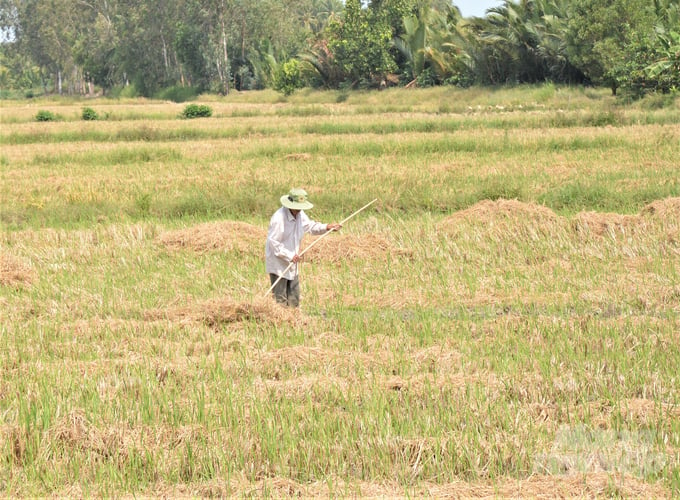
There is no effective solution for managing, collecting and transporting straw plus farmers' practice of burning straw to clean their fields has caused tens of millions of tons of straw to be wasted in the Mekong Delta every year. Photo: Trung Chanh.
Truong Canh Tuyen, Vice Chairman of Hau Giang People's Committee, said that as a purely agricultural province, Hau Giang's rice production area is more than 190,000 ha per year, the rice output exceeds 1 million tons, the same as the amount of straw discharged. However, the rate of rice straw collection is only 15 - 20%, mainly used for mushroom cultivation, not yet diversified in terms of use purposes.
“In order to improve the rice value chain, reduce environmental pollution and greenhouse gas emissions from cultivation, mechanization technology would be an effective method to collect straw and create added value. The agricultural sector needs to provide guidance so that farmers can use rice straw to grow straw mushrooms, make animal feed, cover vegetable crops and orchards, and compost organic fertilizers. Farmers should increase awareness through staw treatment activities, creating many useful products and increasing income," said Vice Chairman Truong Canh Tuyen.
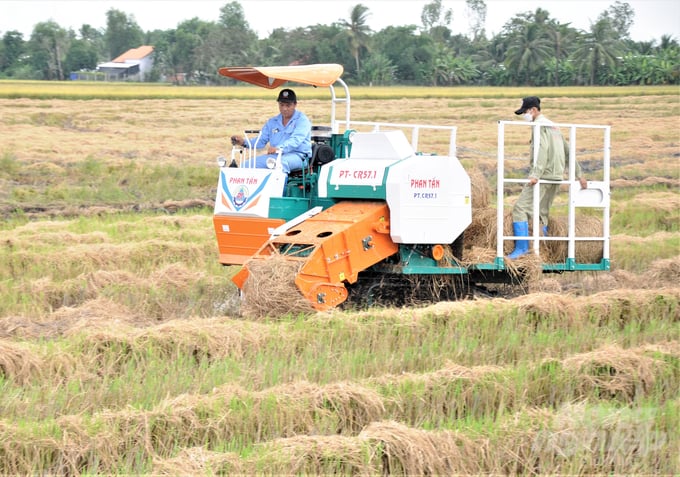
Mechanization technology will help farmers easily collect and move rice straw out of the field and put it to various uses, creating added value. Photo: Trung Chanh.
According to Cao Duc Phat, Chairman of the Board of Directors of the International Rice Research Institute (IRRI), Vietnam is a country where the average rice production acreage per household is not large. In the Mekong Delta, “the rice granary”, it is less than 1 ha/household. One thing to note is that the income from rice farming is not high. In the winter-spring crop when farmers have a successful harvest, the total profit is only 20 million VND/ha. But even that little source of income is under threat with the biggest threats being climate change and sea level rise.
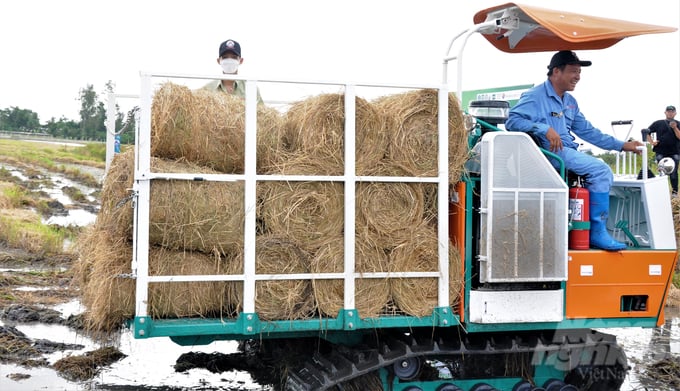
Collecting straw will bring many benefits to the community, reduce environmental pollution and greenhouse gas emissions, increase income for farmers through selling treated straw products, elevate the value of high quality rice in the market and carbon credits on exchanges. Photo: Trung Chanh.
Therefore, in the production process, farmers must pay attention and take measures so as not to exacerbate climate change. In addition to applying advanced farming methods, economical and efficient use of natural resources especially water resources, farmers need to collect straw after each harvest.
“If we apply mechanization to collect rice straw and have certain solutions to treat, process and put it to good use such as growing straw mushrooms, covering vegetable gardens, making animal feed, turning straw into useful agro-products. Farmers can also process them into organic fertilizer to return nutrition to the fields according to the circular farming model, thereby creating a massive source of money for farmers," said IRRI Chairman Cao Duc Phat.
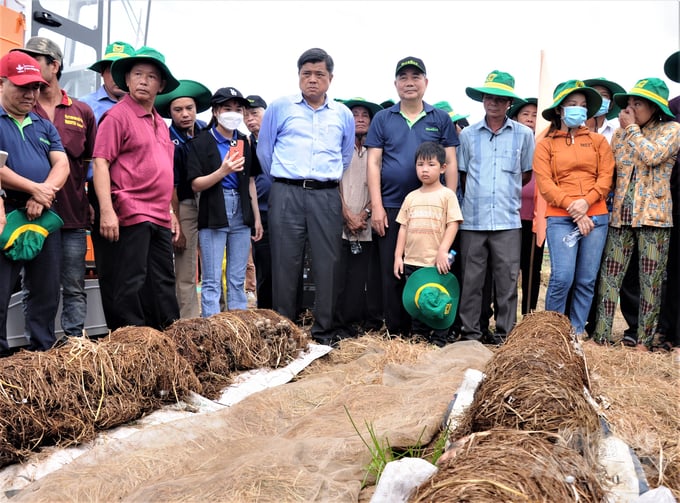
Deputy Minister of Agriculture and Rural Development Tran Thanh Nam, Dr. Cao Duc Phat, Chairman of the Board of Directors of IRRI, and delegates visited a straw mushroom growing model in Hau Giang. Photo: Trung Chanh.
According to Deputy Minister of Agriculture and Rural Development Tran Thanh Nam, Vietnam's rice production still has inadequacies. Post-harvest losses are in large amounts, up to 10%. Agricultural by-products such as straw are a money-making resource but are still being wasted.
“The task of the agricultural sector is not only to restructure commodity production industries but also to develop sustainable production, add value to products, and help farmers increase income while maintaining a good condition of their fields so that they can produce rice for a long time,” said Deputy Minister Tran Thanh Nam.
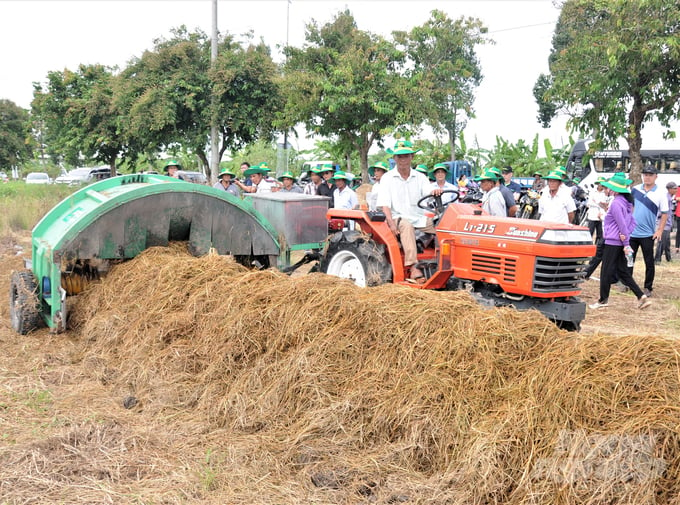
Applying machines to mix straw with livestock waste and other by-products for composting is a promising method to create a circular economic chain in agriculture. Photo: Trung Chanh.
The Ministry of Agriculture and Rural Development is implementing more projects on mechanization for agroproduction, having its focus on developing a mechanization center in the Mekong Delta. expected to operate in Hau Giang province. Not only for display purposes, this center is also the fruit of countless efforts from institutes and universities. It promotes the creative role of enterprises and farmers who are passionate about researching and manufacturing machinery.
The center will be the focal point linking institutes, schools, businesses and cooperatives under the support of the government and banks participating in preferential credit loans, thereby speeding up the application of mechanization to effectively serve agroproduction.
Translated by Samuel Pham

(VAN) 14 out of 35 domesticated elephants in Dak Lak province have had their living conditions improved, with 11 of them currently participating in the non-riding elephant tourism model.

(VAN) Muong Nhe Nature Reserve hopes that being upgraded to a national park will lay the foundation for forest protection efforts to be carried out in a systematic, modern, and sustainable manner.
/2025/05/16/3923-2-171845_52.jpg)
(VAN) Lower costs, higher yields, and improved soil quality are outstanding benefits that soybeans bring when integrated into the crop rotation system.
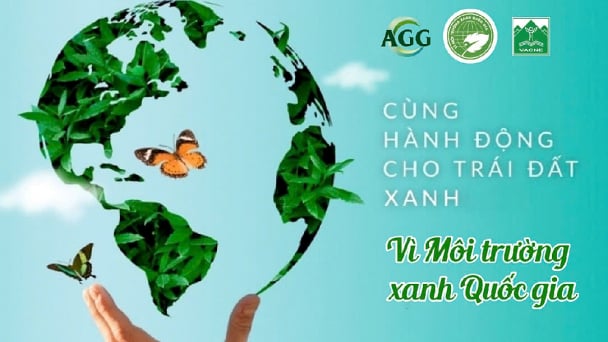
(VAN) The 'For a Green National Environment' programme aims to promote a green lifestyle, support businesses in implementing ESG practices, and turn Net Zero commitments into concrete actions.

(VAN) Cold-barn systems efficiently manage environmental and temperature conditions, which aids in the prevention of respiratory diseases in pigs and protects them from the vectors that transmit African swine fevers.

(VAN) To tackle challenges, the project 'Addressing key technical bottlenecks in the grouper supply chain in Vietnam' has been underway since 2024.

(VAN) The project 'Disease-Resilient and Sustainable Cassava Production Systems in the Mekong Region', funded by the Australian Center for International Agricultural Research (ACIAR), is being implemented from 2024 to 2028.